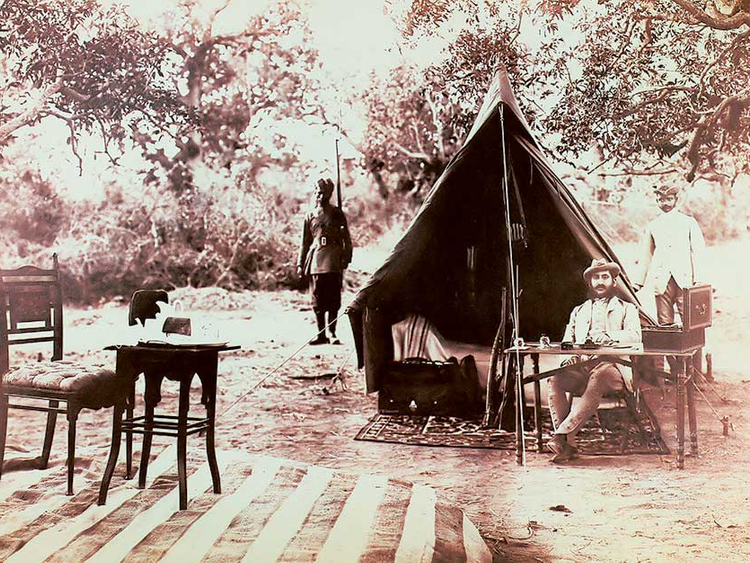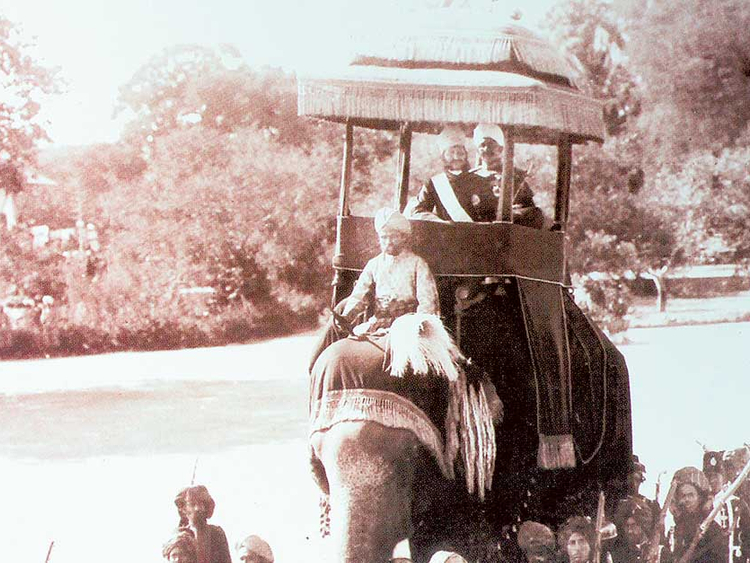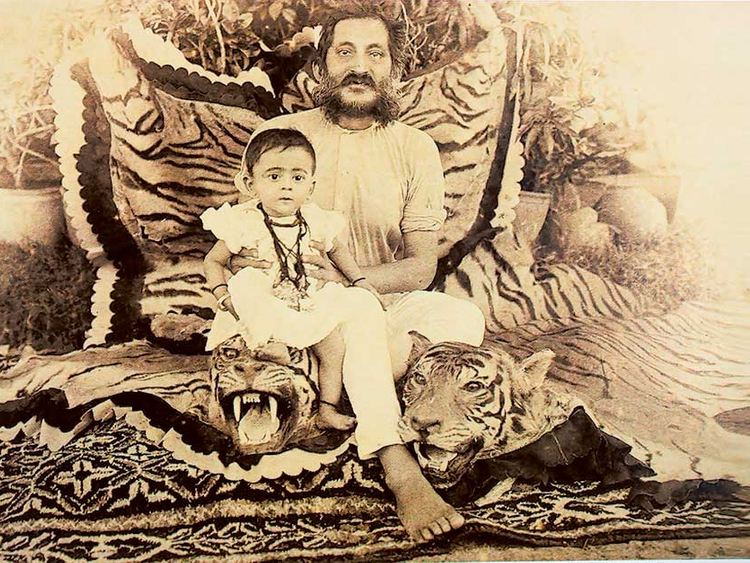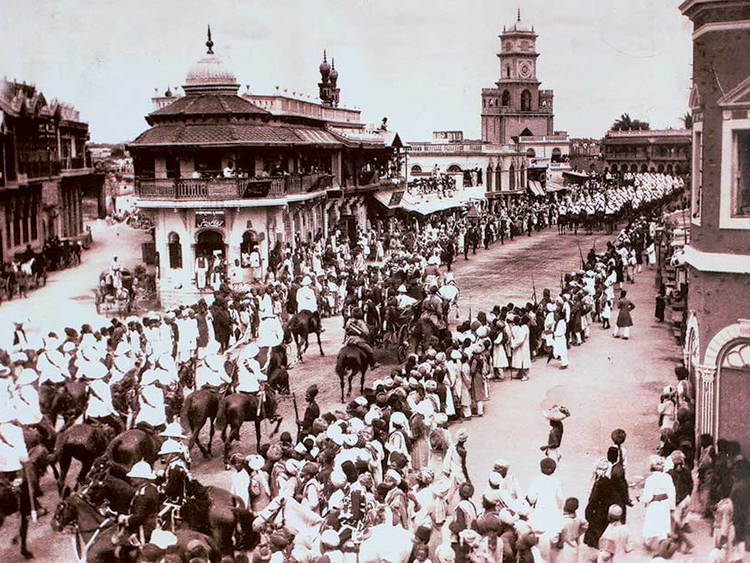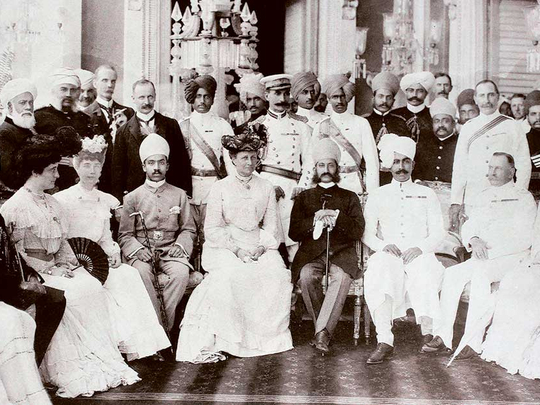
Hyderabad: In the mostly deserted street under the hot son the distraught and worried woman was in a hurry. With a box of cooked food in her hand she was speaking to herself loudly. “May God’s curse be on him, the Daroga of the Palace is not allowing my son to go home even to eat. My child is on guard’s duty since last night”.
Not far behind her was a man covering his face with a piece of cloth, looking curiously and listening intently. He kept walking for some distance before catching up with the old lady. “What happened? Who’s stopping your son from going home?” He inquired.
“Tipu Khan, the Daroga [chief officer] of the Palace,” she replied continuing to hurry. Then she stopped and looked carefully at the man. “But why are you asking me? You also look hungry to me? Why don’t you eat something from this food here?”
A color portrait of the 6th Nizam.
The kind lady offered the box of food to the man who hesitantly accepted and took a few bites before returning the box to her.
On reaching the gates of the Palace the lady sought permission for entry to feed her son. The sentries at the gate stopped her and searched her belongings including the food box. The sentries and the woman were shocked as one of the boxes was found filled with Ashrafis or the gold ringlet or quid.
Suspecting her to be a thief, the guards dragged her to Tipu Khan, the Daroga who demanded to know the source of the wealth. Before the woman could say something, the same man appeared.
“This is the reward I have given to her for her generosity and large heartedness. She did not forget to offer food to a hungry person even when her son was starving.” And then the person revealed his identity. “I am the King.”
This was Mir Mahboub Ali Khan, Asaf Jah the Sixth or the Sixth Nizam of Hyderabad who was endearingly referred to by his subjects as Mahboub Ali Pasha or the Beloved and still remembered as such in the stories passed from generation to generation.
Though the princely state of Hyderabad was ruled by ten rulers during the Asif Jahi dynasty from 1724 to 1948 (Only seven of them were given the title of Asaf Jah by the Mughal Emperor), it was the sixth Nizam who was the most popular of them all and who ruled the hearts of his subjects cutting across the faith, caste and creed and whose 27-year era was called the “Most “Romantic Era of Hyderabad’s history”.
The above anecdote was not an isolated example but it was the norm for the ruler to roam around during the day and night, mingling with his subjects to know their living conditions, problems and sufferings making him a real friend of his people. Perhaps this also explains why even 105 years after his death he is still remembered fondly by the people.
Masses and officials knew of this practice and were wary of any stranger fearing he could be the Nizam going around incognito.
“As far as I know there were only three rulers in the known history who would roam around like this. First was the Caliph Omar Ibn Khattab, second was Abbasid Caliph Haroun Al Rasheed and third was Mahboub Ali Pasha who took care of their subjects in this manner,” said Mohammad Safiullah, a prominent historian of Hyderabad and honorary secretary of Deccan Heritage Trust, who organised an exhibition of the rare photos of the sixth Nizam at Chowmohalla Palace on his 150th Birth anniversary on August 17.
Generosity
The life and times of the sixth Nizam were filled with fables. Once during his round of the city he heard the wailing of a woman. “Kis maati mile ki hukumat hai [which wretched ruler is ruling us]. My children are starving and crying. They can’t sleep on an empty stomach and there is nobody to help.”
The Nizam broke down. In shock and grief, he immediately went back to his palace and ordered the gates to be opened for anybody who was starving.
On another such incognito trip he stopped a Tongawalla (horse cart driver) to take a ride. When asked how the ruler of the state was, the Tongawalla retorted, “Sahab App kis Manhoos Ka naam liye” [You have taken the name of which wretched person]. On further questioning by the Nizam, he lamented his woes. “I am a very poor person. I am driving this carriage on hire of six Aana (36 paise) a day and after a day’s hard work make hardly one rupee. How can I survive like this, but our ruler is content with eating, sleeping and making merry.”
The Nizam kept mum.
After going around for an hour, the Nizam took him to his palace and got down at the gate and went inside. Realising whom he was talking to, the Tongawala started shivering over the prospects of physical punishment. After a while a man came out with a bag full of gold ringlets (Ashrafis) and a written order that the man should purchase a new carriage for himself and live a better life.
It was this generosity and habit of keeping the strings of the purse loose which resulted in the richest man of the world at the time always facing financial hardship. Mahboub Ali Khan was named the next Nizam at the tender age of two years and seven months in February 1869 on the death of his father Afzal-ud-Daula as he was the only son of the fifth Nizam. However his real rule started in 1884, continuing until his death on August 29, 1911.
During his childhood, when he was under the tutelage of the likes of Sir Salar Jung I Mir Turrab Ali Khan, the Prime Minister and other regents from the Nobles of Paigah Family including Sarwar-ul-Mulk, the charming prince was taught and trained by the British teachers as well as the local Moulvis and was proficient in English, Urdu and Persian.
By the time he effectively took over the reins of power, Mahboub Ali Pasha had grown into a handsome and charismatic personality who was equally comfortable in European attire and local traditional fashions.
“He was the most handsome man of his times. Very fashionable, always impeccably dressed,” said Safiullah quoting Basalt Jah, the youngest son of the sixth Nizam who passed away in 1993.
“In today’s language you could call him a cool dude. He was such a relaxed person that people could lie down on the ground in his presence. We can’t imagine such a thing in case of other rulers including the last Nizam Mir Osman Ali Khan,” said Safiullah, pointing to the photos of his hunting expeditions in his rare collection of hundreds of photos.
“His era was most stable, peaceful marked by development, progress and prosperity for all. He was a secular ruler who always cared for the masses irrespective of their faith and religion. His was a secular society in which most of the prime ministers were from the Hindu community. Maharaja Kishan Prasad was one of them,” said Safiullah.
The establishment of Nizam’s Railways, a number of educational institutions like the famous Chadarghat state school, Madrsa-e-Aaliya, Mahbubiya School, Nizam’s Observatory, introduction of electricity in Hyderabad for the first time, directorate of the jail and police department, Asafia Library, Dairataul Maarif, and discovery of malaria-causing parasite in mosquitos by Ronald Ross were among the many remarkable developments reflecting the changes in Hyderabad society from medieval to the modern times thanks to the modernist and pragmatic outlook of the ruler. The white Town Hall building (present state Assembly building) was also built during his time.
Reflecting the changing times, he replaced Persian with Urdu as the language of his administration and issued orders to encourage the local people to join the administration, which was until then dominated by learnt people from North India.
The most challenging and difficult time of his era was the deadly flood of the river Musi, which passes through the heart of Hyderabad, on September 28, 1908.
It claimed more than 15,000 lives and left 80,000 homeless. Many parts of the city were devastated completely following 32-inch rains that flooded the two lakes and their embankments were breached leading to the massive floods.
Taste for clothes
Setting a new precedent for future rulers, Mahboub Ali Khan, without caring for his personal safety and security, came out to be with his subjects in the hour of trauma and tribulation and personally supervised the relief and rescue operations.
When he saw the death and destruction wreaked by the river, the king broke down in full public view. Summing up those heartrending scenes, the famous poetess and Nightingale of India Sarojini Naidu wrote the famous poem Tears of Asif.
“He donated Rs4.5 lakh [Rs450,000 in today’s value equivalent to Rs5 billion or Dh275 million] from his pocket for the relief works and also to feed 80,000 people for three months,” said Safiullah.
Such was his concern for the safety of his subjects that he accepted the suggestion of the Hindu priests without hesitation to take part in rituals of offering diamonds and other precious stones along with a golden sword, bare bodied with the holy thread — like a Brahmin.
“The priests told him this will placate the river Musi,” said Safiullah referring to the records of those days.
He also sought help from the famous engineer M. Vishweshwaraiah, to find a permanent solution to the problem of floods in river Musi, which resulted in construction of the two reservoirs Himayat Sagar and Osman Sagar that continue to be sources of drinking water for the city even today.
He was a remarkable person in many other ways. He was fond of Shikar or hunting as numerous photos with the hunted animals including tigers and black bucks show.
“He was not a poacher but a systematic hunter who never killed the female of the species. Only males would be hunted by him. Whenever he would set on hunting expeditions in the forest of Adilabad and Warangal, it would provide employment opportunities to hundreds of people as it would involve a lot of preparation and arrangements,” he recalled.
A man of attractive personality and a mesmerising gaze Mahboub Ali Pasha had a remarkable taste for clothing and other accessories. “He had an enormous collection of garments including sherwanis, shirts, coats, collars, socks, shoes, headgears of various styles, walking sticks and perfumes”.
South African diamond
In fact Msarrat Mahal palace in Purani Haveli, which was his residence had the world’s biggest wardrobe to match the biggest collection of clothes, which he never used twice.
The wardrobe was still intact and part of the Nizam’s Museum run by his descendants. Same was the story of his collection of motor cars, a passion carried forward by his eldest son and the last Nizam, Mir Osman Ali Khan.
The man of refined tastes, who matched with the English residents and other officials and even the visiting British royalty during the time would also occasionally show disdain for wealth. After acquiring the world’s biggest diamond “Jacob” from a merchant from South Africa for Rs2.3 million at the time, it was left in one of his warehouses as he did not like it.
“The 184.5 carat diamond was double the size of the Koh-i-Noor but the Nizam did not like it. Even his successor used it as a paper weight in his office,” says Safiullah.
The magnificent Falaknuma Palace, where he breathed his last on August 29, 1911 following a stroke, was another prized possession he acquired by paying Rs6.8 million from Waqar-ul-Umra.
“He was a benevolent king who had a lot of concern for his subjects. He was secular who treated everybody equally.
“He loved the local language, culture and customs. There cannot be a culture without taking into consideration the contribution made by the Asaf Jahis, and Qutub Shahis and the Kakatiyas,” Safiullah said.
“That is the reason we are urging the state government to include the positive aspects of the history of Kakatiya, Qutub Shahi (the founders of Hyderabad) and the Asaf Jahi rulers in the school textbooks so the new generation can take pride in their glorious past,” said Safiullah, who heads the Deccan Heritage Trust.
Safiullah who is researching the life and times of Mahboub Ali Pasha, is very possessive of his huge collection of photos and rare artefacts of the Asaf Jahi era.
A few of the photographs were given to him by Basalat Jah, the youngest son of the sixth Nizam.



